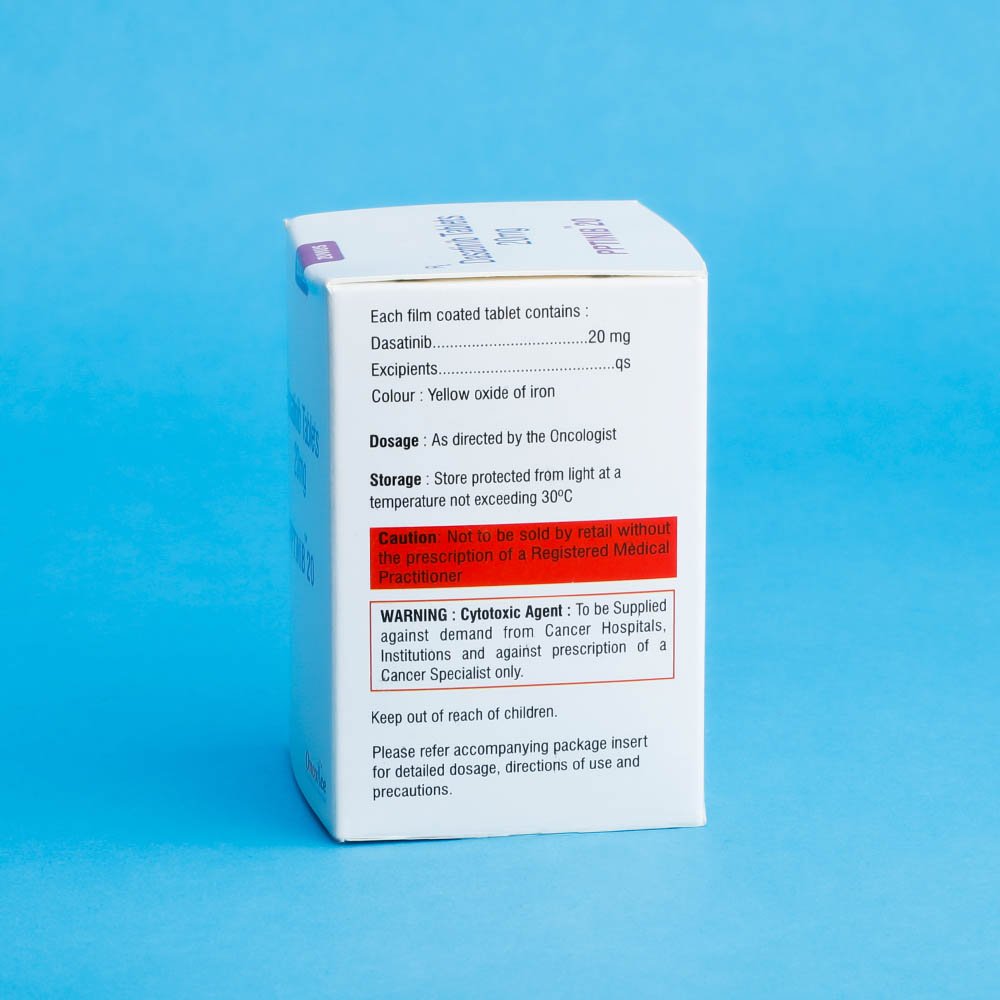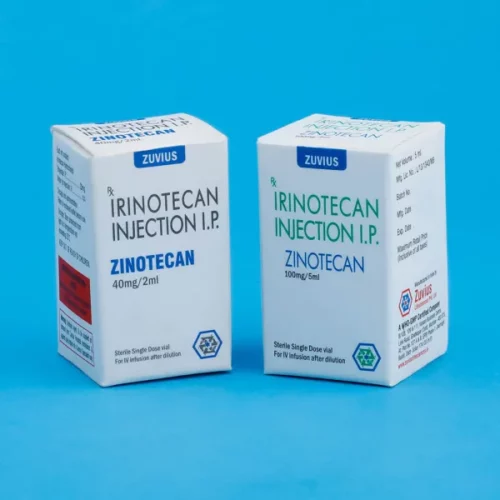PPTINIB Tab- Dasatinib Tab
Dasatinib Tab
Strength: 20mg / 50mg / 70mg
Pack Size: 1 x 60
Drug Class: Antineoplastic agents, protein kinase inhibitors
Dosage and Administration:
Dosage Of PPTINIB Tab In Adult Patients
The recommended starting dosage of PPTINIB Tab for chronic phase CML in adults is 100 mg administered orally once daily. The recommended starting dosage of PPTINIB for accelerated phase CML, myeloid or lymphoid blast phase CML, or Ph+ ALL in adults is 140 mg administered orally once daily. Tablets should not be crushed, cut, or chewed; they should be swallowed whole. PPTINIB can be taken with or without a meal, either in the morning or in the evening.
Dosage Of PPTINIB Tab In Pediatric Patients
The recommended dose should be administered orally once daily with or without food. Recalculate the dose every 3 months based on changes in body weight, or more often if necessary.
Do not crush, cut or chew tablets. Swallow tablets whole. The exposure in patients receiving a crushed tablet is lower than in those swallowing an intact tablet.
Cold Storage: no
PPTINIB Tab(dasatinib) is a kinase inhibitor. The chemical name for dasatinib is N-(2-chloro-6-methylphenyl)-2-[[6-[4-(2-hydroxyethyl)-1-piperazinyl]-2-methyl-4-pyrimidinyl]amino]-5-thiazolecarboxamide, monohydrate. The molecular formula is C22H26ClN7O2S • H2O, which corresponds to a formula weight of 506.02 (monohydrate). The anhydrous free base has a molecular weight of 488.01. Dasatinib has the following chemical structure:
 |
PPTINIB Tab is a white to off-white powder. The drug substance is insoluble in water and slightly soluble in ethanol and methanol.
PPTINIB tablets are white to off-white, biconvex, film-coated tablets containing dasatinib, with the following inactive ingredients: lactose monohydrate, microcrystalline cellulose, croscarmellose sodium, hydroxypropyl cellulose, and magnesium stearate. The tablet coating consists of hypromellose, titanium dioxide, and polyethylene glycol.
Dasatinib is indicated for the treatment of adult patients with:
– Ph+ acute lymphoblastic leukaemia (ALL) with resistance or intolerance to prior therapy.
Dasatinib is indicated for the treatment of paediatric patients with:
– newly diagnosed Ph+ ALL in combination with chemotherapy.
newly diagnosed adults with Philadelphia chromosome-positive (Ph+) chronic myeloid leukemia (CML) in chronic phase. The trial is ongoing and further data will be required to determine long-term outcome.
• adults with chronic, accelerated, or myeloid or lymphoid blast phase Ph+ CML with resistance or intolerance to prior therapy including imatinib.
• adults with Philadelphia chromosome-positive acute lymphoblastic leukemia (Ph+ ALL) with resistance or intolerance to prior therapy.
Clinical efficacy and safety
In the Phase I study, haematologic and cytogenetic responses were observed in Ph+ ALL in the first 84 patients treated and followed for up to 27 months. Responses were durable across Ph+ ALL. The efficacy of dasatinib is based on haematological and cytogenetic response rates. Durability of response and estimated survival rates provide additional evidence of dasatinib clinical benefit. A total of 2,712 patients were evaluated in clinical studies; of these 23% were ≥ 65 years of age and 5% were ≥ 75 years of age. Ph+ ALL An open-label, single-arm, multicentre study was conducted in patients with Ph+ ALL who were resistant or intolerant to prior imatinib therapy. In addition, 46 patients with Ph+ ALL received dasatinib 70 mg twice daily (44 resistant and 2 intolerant to imatinib). The median time from diagnosis to start of treatment was 18 months. Median duration of treatment on dasatinib was 3 months with 7% of patients treated for > 24 months to date. The rate of major molecular response (all 25 treated patients with a CCyR) was 52% at 24 months.Of note, major haematologic responses (MaHR) were achieved quickly (within 55 days for patients with Ph+ ALL).
Phase III clinical studies in patients with Ph+ ALL who were resistant or intolerant to imatinib
Two randomised, open-label studies were conducted to evaluate the efficacy of dasatinib administered once daily compared with dasatinib administered twice daily. Results described below are based on a minimum of 2 years and 7 years follow-up after the start of dasatinib therapy.
Study 2
In the study in Ph+ ALL, the primary endpoint was MaHR. A total of 611 patients were randomised to either the dasatinib 140 mg once daily or 70 mg twice daily group.Median duration of treatment was approximately 6 months (range 0.03-31 months). The once daily schedule demonstrated comparable efficacy (non-inferiority) to the twice daily schedule on the primary efficacy endpoint (difference in MaHR 0.8%; 95% confidence interval [-7.1% – 8.7%]); however, the 140 mg once daily regimen demonstrated improved safety and tolerability.
The non-clinical safety profile of dasatinib was assessed in a battery of in vitro and in vivo studies in mice, rats, monkeys, and rabbits.
The primary toxicities occurred in the gastrointestinal, haematopoietic, and lymphoid systems. Gastrointestinal toxicity was dose-limiting in rats and monkeys, as the intestine was a consistent target organ. In rats, minimal to mild decreases in erythrocyte parameters were accompanied by bone marrow changes; similar changes occurred in monkeys at a lower incidence. Lymphoid toxicity in rats consisted of lymphoid depletion of the lymph nodes, spleen, and thymus, and decreased lymphoid organ weights. Changes in the gastrointestinal, haematopoietic and lymphoid systems were reversible following cessation of treatment. Renal changes in monkeys treated for up to 9 months were limited to an increase in background kidney mineralisation. Cutaneous haemorrhage was observed in an acute, single-dose oral study in monkeys but was not observed in repeat-dose studies in either monkeys or rats. In rats, dasatinib inhibited platelet aggregation in vitro and prolonged cuticle bleeding time in vivo, but did not invoke
spontaneous haemorrhage. Dasatinib activity in vitro in hERG and Purkinje fiber assays suggested a potential for prolongation of
cardiac ventricular repolarisation (QT interval). However, in an in vivo single-dose study in conscious telemetered monkeys, there were no changes in QT interval or ECG wave form. Dasatinib was not mutagenic in in vitro bacterial cell assays (Ames test) and was not genotoxic in an in vivo rat micronucleus study. Dasatinib was clastogenic in vitro to dividing Chinese Hamster Ovary
(CHO) cells.
Dasatinib did not affect male or female fertility in a conventional rat fertility and early embryonic development study, but induced embryolethality at dose levels approximating human clinical exposures. In embryofoetal development studies, dasatinib likewise induced embryolethality with associated decreases in litter size in rats, as well as foetal skeletal alterations in both rats and rabbits.
These effects occurred at doses that did not produce maternal toxicity, indicating that dasatinib is a selective reproductive toxicant from implantation through the completion of organogenesis. In mice, dasatinib induced immunosuppression, which was dose-related and effectively managed by dose reduction and/or changes in dosing schedule. Dasatinib had phototoxic potential in an in vitro
neutral red uptake phototoxicity assay in mouse fibroblasts. Dasatinib was considered to be nonphototoxic in vivo after a single oral administration to female hairless mice at exposures up to 3-fold the human exposure following administration of the recommended therapeutic dose (based on AUC). In a two-year carcinogenicity study, rats were administered oral doses of dasatinib at 0.3, 1, and 3
mg/kg/day. The highest dose resulted in a plasma exposure (AUC) level generally equivalent to the human exposure at the recommended range of starting doses from 100 mg to 140 mg daily. A statistically significant increase in the combined incidence of squamous cell carcinomas and papillomas in the uterus and cervix of high-dose females and of prostate adenoma in low-dose males
was noted. The relevance of the findings from the rat carcinogenicity study for humans is not known.
Myelosuppression: Severe thrombocytopenia, neutropenia, and anemia
may occur and require dose interruption or reduction. Monitor complete blood counts regularly.
• Bleeding Related Events (mostly associated with severe thrombocytopenia): CNS and gastrointestinal hemorrhages, including fatalities, have occurred. Severe hemorrhage may require treatment interruptions and transfusions. Use Dasatinib with caution in patients requiring medications that inhibit platelet function or anticoagulants.
• Fluid Retention: Dasatinib is associated with fluid retention, sometimes severe, including ascites, edema, and pleural and pericardial effusions. Manage with appropriate supportive care measures.
• QT Prolongation: Use Dasatinib with caution in patients who have or may develop prolongation of the QT interval.
• Congestive Heart Failure, Left Ventricular Dysfunction and Myocardial Infarction: Monitor patients for signs or symptoms consistent with cardiac dysfunction and treat appropriately.
• Fetal harm may occur when administered to a pregnant woman. Women should be advised of the potential hazard to the fetus and to avoid becoming pregnant.




















